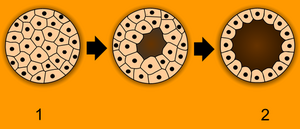Types of animal eggs and their cleavage
An egg (lat. ovum) is a female sex cell (gamete), which is created during a process called oogenesis and carries the genetic material of the mother. Eggs of different animals have different contents and different distribution of storage substances ("yolk") in the cytoplasm, and this affects their groove.
The human ovum is oligolecithal, isolecithal and holoblastic, it is grooved totally and equally.
Eggs of animals[edit | edit source]
Types of eggs according to the amount of yolk[edit | edit source]
Oligolecithal = miolecithal, microlecithal[edit | edit source]
- Little yolk – there is no obstacle during furrowing, the zygote divides into two blastomeres, then into four, eight,...,
- microscopic dimensions,
- complete furrowing (blastomeres completely separate from each other) – holoblastic eggs,
- example – eggs of mammals, except for birds and lancefish eggs
Mesolecithal = mediolecithal[edit | edit source]
- A considerable amount of yolk, still does not prevent complete creasing,
- the eggs are larger (diameter 2–3 mm),
- example – amphibian eggs.
Polylecithal = macrolecithal, megalolecithal[edit | edit source]
- Enormous amount of yolk - an obstacle in the separation of blastomeres (incomplete),
- during further divisions, separate blastomeres are formed at the animal pole of the egg - there is not much yolk here,
- the vegetative pole - with a larger amount of yolk - does not groove,
- partial striation – meroblastic eggs.
Types of eggs according to the distribution of the yolk in the cytoplasm[edit | edit source]
Isolecital[edit | edit source]
- The yolk is evenly distributed in the cytoplasm ,
- total striation, equally sized blastomeres – equal striation,
- occurrence – oligolecithal eggs of mammals and eggs of many invertebrates.
Telolecital[edit | edit source]
- Yolk at the vegetative (heavier) pole of the egg (little yolk at the animal pole, nucleus of the oocyte ) → polar differentiation,
- different size of blastomeres – micromeres at the animal pole, macromeres at the vegetative pole,
- uneven scoring,
- occurrence – mesolecithal and polylecithal eggs, spearfish egg.
Extremely telolecital[edit | edit source]
- Polylecithal eggs of reptiles and birds,
- the vegetative pole does not split at all,
- animal pole – formation of the germinal target by gradual furrowing,
- discoidal striations.
Centrolecital[edit | edit source]
- Accumulated yolk surrounded by a layer of cytoplasm without yolk,
- blastomeres separate on the surface during furrowing – superficial division,
- occurrence - arthropods.
Grooving progress[edit | edit source]
Striation is essentially several consecutive mitoses . During each mitosis, the genetic information of the mother cell is passed equally to the daughter cells. The daughter cell, in the case of furrowing, is called a blastomere . The blastomere does not acquire the size of the mother cell and divides further. Thus, during subsequent mitoses, the blastomere continues to shrink. Restoring the cells to their original size is ensured by scoring .
Grooving depends on the type of egg, or rather on the content and distribution of storage substances (yolk) in the cytoplasm of the egg. The yolk is an obstacle to cell rutting.
The course of furrowing is directed and controlled by the genome of the zygote. During furrowing, increasingly complex structures and functions of a multicellular organism are formed. During these morphogenetic processes, cell multiplication - proliferation , movements and transfers of cells and cell differentiation - differentiation , as well as cell death - apoptosis are applied .
Morphogenetic processes can be disrupted by various internal ( chromosomal deviations ) and external (influences of the maternal environment) influences. It works mainly in the so-called critical period.
By the first furrowing, the zygote is divided into two identical blastomeres. These are still stored in the zona pellucida . This stage is reached 24–30 hours after fertilization. Gradually (40–50 hours after fertilization), a four-cell stage occurs, in which two blastomeres are larger and two are smaller. Larger blastomeres divide earlier because the yolk is not completely evenly distributed in the cytoplasm, even if it is an isolecithal egg. This is followed by further furrowing (up to the sixteen-cell stage), which takes place during the movement of the egg through the fallopian tube. The sixteen-cell stage is reached about 60 hours after fertilization.
Links[edit | edit source]
Related Articles[edit | edit source]
References[edit | edit source]
- VACEK, Zdeněk. Embryologie pro pediatry: učebnice pro lékařské fakulty. 2. edition. Praha : Nakladatelství a vydavatelství JP, 1992. 313 pp. ISBN 80-7066-562-9.



